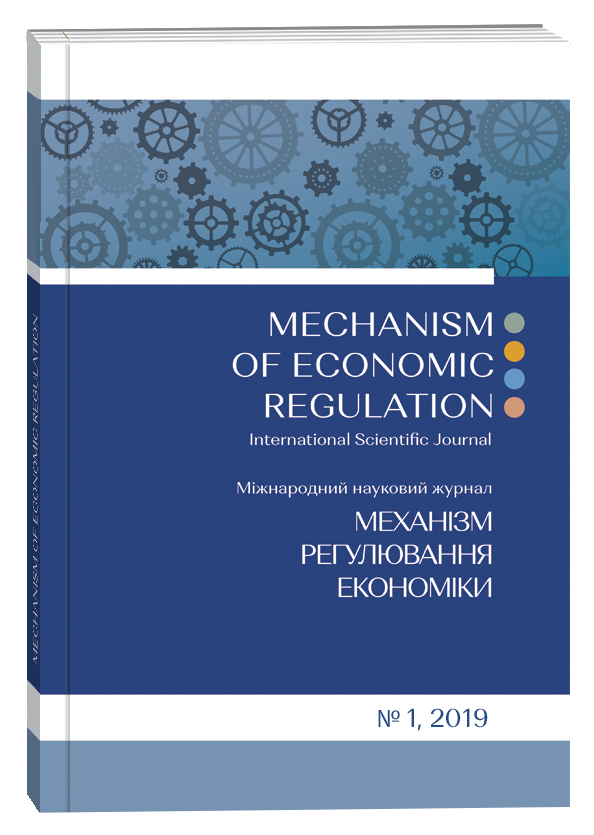INNOVATIVE DEVELOPMENT OF UKRAINE: STRATEGIES, MODELS, MECHANISMS
Abstract
The relationship between innovation activity and competitiveness is considered in the article. The stronger the competition, the more active the business entities develop and implement them, providing an innovative basis for their own strong competitive position and competitiveness of Ukraine. So, in fact, in Ukraine, there is a “gap” between the possibilities for generating innovations and the conditions for their generation and implementation. The possibility and necessity of the innovative development of Ukraine based on the use of a sufficiently powerful innovative potential and other factors contributing to the innovative development of the economy are substantiated. This requires the state to create conditions for protecting competition, defining a system of strategies and developing a strategic plan for its implementation. A set-theoretic model of the strategy system and a model of the mechanism for implementing the general strategy of economic management – the strategy of innovative development are proposed. To implement the strategy of innovative development of Ukraine, it is offered to develop intellectual-oriented entrepreneurship as an innovative strategy. The implementation of the chosen innovation strategy should be carried out in two strategic areas: increasing human capital and activation the formation of human potential, the creation of conditions for the implementation of intellectual- oriented entrepreneurship. It was proposed to include in the strategy system a number of key functional strategies that are consistent with the overall strategy and ensure its implementation: educational – development of intellectual abilities and competencies, structural-sectoral – priority development of high-tech and non-material-intensive industries and active use of knowledge potential for the modernization of all sectors of the economy, organizational and structural – the formation of a cluster model of the economy. Ukraine needs an information strategy for information support of innovative economic development and a mechanism for its implementation.
References
Amosha, O. I. (2005). Innovacijny`j shlyax rozvy`tku Ukrayiny: problemy ta rishennya [Innovative way of development of Ukraine: problems and solutions]. Ekonomist, 6, 28–32.
Grynko, T. V. (2013). Innovacijnyj rozvytok Ukrayiny: tendenciyi ta problemy [Innovative development of Ukraine: trends and problems]. Tekhnolohycheskyi audyt y rezervy proyzvodstva, 1/3(9), 17–21.
Fedulova, L. I. (red.) (2005). Innovacijnyj rozvytok ekonomiky: model, systema upravlinnya, derzhavna polityka [Innovative economic development: model, management system, state policy]. Кyiv: Osnova, 552.
Odotiuk, I. V. (2012). Suchasna innovatsiina polityka Ukrainy: peredumovy, osnovni pidkhody ta napriamy reformuvannia [Modern innovation policy of Ukraine: preconditions, basic approaches and directions of reforming]. Visnyk NAN Ukrainy, 7, 32–46.
Khomenko, O. V. (2011). Innovatsiina konkurentospromozhnist krain [Innovative competitiveness of the countries]. Aktualni problemy ekonomiky, 8, 100–105.
Afanasiev, Ye. V. (2013). Modeliuvannia makroekonomichnykh innovatsiinykh protsesiv u systemi derzhavnoho rehuliuvannia rozvytku ekonomiky Ukrainy [Modeling of macroeconomic innovation processes in the system of state regulation of the development of the Ukrainian economy]. Efektyvna ekonomika, 6. Retrieved from http://www.economy.nayka.com.ua/?op=1&z=2141.
Hladynets, N. Yu. (2015). Modeliuvannia indykatoriv rehionalnoho innovatsiinoho rozvytku [Modeling indicators of regional innovation development]. Naukovyi visnyk Mukachivskoho derzhavnoho universytetu. Seriia «Ekonomika», 1(3), 134–140.
Lukianenko, I. H. (2013). Modeliuvannia innovatsiinoi aktyvnosti ukrainskykh promyslovykh pidpryiemstv [Modeling of innovative activity of ukrainian industrial enterprises]. Naukovi zapysky NaUKMA. Ekonomichni nauky, 146, 73–80.
Rud, N. T. (2010). Modeliuvannia innovatsiinykh protsesiv rehionu [Modeling of innovation processes in the region]. Retrieved from http://ena.lp.edu.ua/bitstream/ntb/18786/1/13-52-59.pdf.
WEF (2018). The Global Competitiveness Report 2017–2018. World Economic Forum, Geneva. Retrieved from http//www.weforum.org.
WEF (2016). The Global Competitiveness Report 2015–2016. World Economic Forum, Geneva. Retrieved from http//www.weforum.org.
WEF (2017). The Global Competitiveness Report 2016–2017. World Economic Forum, Geneva. Retrieved from http//www.weforum.org.
Vprovadzhennia innovatsii na promyslovykh pidpryiemstvakh [Implementation of innovations at industrial enterprises]. Retrieved from http://www.ukrstat.gov.ua.
INSEAD (2016). The Global Talent Competitiveness Index 2015–2016. Retrieved from https://www.insead.edu.
INSEAD (2017). The Global Talent Competitiveness Index 2017. Retrieved from https://www.insead.edu.
INSEAD (2018). The Global Talent Competitiveness Index 2018. Retrieved from https://www.ins ead.edu.
Shevchenko, L. S. (red.) (2012). Sotsialna derzhava: dosvid polityko-ekonomichnoho analizu [Social state: experience of political and economic analysis]. Kharkiv: Law Academy of Ukraine named after Yaroslav the Wise, 275.
Upravlinnia znanniamy: zvit II Mizhnarodnoi HR konferentsii [Knowledge Management: report of the II International HR conference]. Retrieved from http://www.management.com.ua.
Porter, M. (2006). Konkurentsyia [Competition]. Moscow: Dialectics, 608.
Ivanova, V. V. (2011). Informatsiine zabezpechennia ekonomiky, zasnovanoi na znanniakh [Information support of the knowledge-based economy]. Кyiv: Logos, 277.


